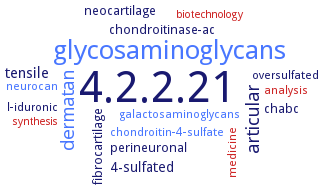4.2.2.21: chondroitin-sulfate-ABC exolyase
This is an abbreviated version!
For detailed information about chondroitin-sulfate-ABC exolyase, go to the full flat file.

Word Map on EC 4.2.2.21 
-
4.2.2.21
-
glycosaminoglycans
-
articular
-
dermatan
-
tensile
-
4-sulfated
-
chabc
-
neocartilage
-
fibrocartilage
-
perineuronal
-
chondroitinase-ac
-
oversulfated
-
l-iduronic
-
neurocan
-
analysis
-
medicine
-
galactosaminoglycans
-
chondroitin-4-sulfate
-
synthesis
-
biotechnology
- 4.2.2.21
- glycosaminoglycans
-
articular
- dermatan
-
tensile
-
4-sulfated
- chabc
-
neocartilage
-
fibrocartilage
-
perineuronal
-
chondroitinase-ac
-
oversulfated
-
l-iduronic
- neurocan
- analysis
- medicine
- galactosaminoglycans
- chondroitin-4-sulfate
- synthesis
- biotechnology
Reaction
Synonyms
BactnABC, cABCII, chABC, Chondroitin Sulfate Lyase ABC, chondroitinase ABC, chondroitinase ABC II, chondroitinase AC, chondroitinase ACII, chondroitinase-ABC, ChS ABC lyase II, EC 4.2.2.4, EC 4.2.99.6, HCLase
ECTree
Advanced search results
Systematic Name
Systematic Name on EC 4.2.2.21 - chondroitin-sulfate-ABC exolyase
Please wait a moment until all data is loaded. This message will disappear when all data is loaded.
chondroitin-sulfate-ABC exolyase
This enzyme degrades a variety of glycosaminoglycans of the chondroitin-sulfate- and dermatan-sulfate type. Chondroitin sulfate, chondroitin-sulfate proteoglycan and dermatan sulfate are the best substrates but the enzyme can also act on hyaluronan at a much lower rate. Keratan sulfate, heparan sulfate and heparin are not substrates. The related enzyme EC 4.2.2.20, chondroitin-sulfate-ABC endolyase, has the same substrate specificity but produces a mixture of oligosaccharides of different sizes that are ultimately degraded to tetra- and disaccharides [4]. Both enzymes act by the removal of a relatively acidic C-5 proton of the uronic acid followed by the elimination of a 4-linked hexosamine, resulting in the formation of an unsaturated C4---C5 bond on the hexuronic acid moiety of the products [4,6].


 results (
results ( results (
results ( top
top





